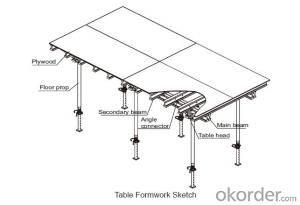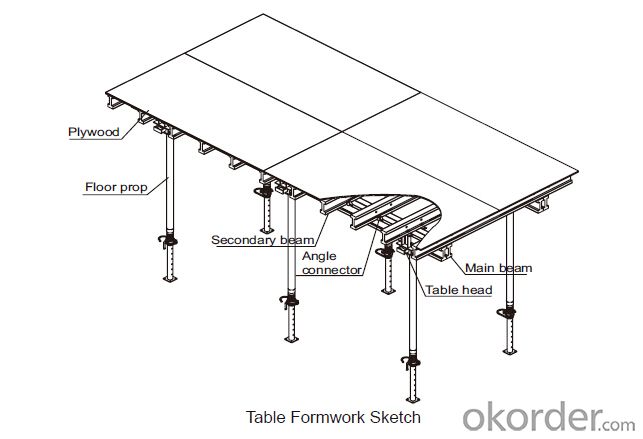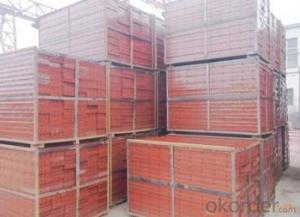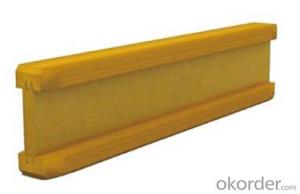Tabel-Formwork for Formwork and Scaffolding System
- Loading Port:
- Tianjin
- Payment Terms:
- TT OR LC
- Min Order Qty:
- 50 m²
- Supply Capability:
- 1000 m²/month
OKorder Service Pledge
OKorder Financial Service
You Might Also Like
Tabel Formwork:
Table formwork is the most typical application for slab, with timber beam, the slab formwork is
light weight, fast and economic in the construction.
Characteristics:
◆ Simple structure, easy assembly.
◆ Flexible structure, be adapted to different support system.
◆ High construction efficiency with special system tools.
1. Lifting fork for lifting the table formwork to upper floor.
2. Trolley for moving the table formwork on floor.
◆ Flexible application with stand alone props.
◆ Safer condition with handrails.
- Q: What are the considerations when selecting the size and spacing of steel formwork panels?
- Several important considerations need to be made when choosing the size and spacing of steel formwork panels. To begin with, the specific requirements of the project should dictate the size of the panels. Factors like the dimensions and shape of the concrete structure being formed, as well as the load-bearing capacity of the panels, must be taken into account. Selecting panel sizes that can adequately support the weight of the concrete and any additional loads during construction is crucial. The spacing of the steel formwork panels is another crucial factor to consider. It should be determined based on the desired concrete thickness and the panels' ability to resist deflection or bending under the concrete's weight. The spacing should be close enough to prevent excessive sagging or bulging of the panels, which could result in an uneven concrete surface. Moreover, the spacing should allow for easy installation, removal, and handling of the formwork panels. This is especially important for efficient and cost-effective construction processes. Sufficient spacing between the panels will enable smooth and safe placement and removal of the formwork, reducing the risk of accidents or delays. Additionally, the spacing should also consider the size and accessibility requirements for construction equipment and workers. Ample space between the panels will allow for the movement and operation of equipment, such as cranes or concrete pumps, and ensure that workers can safely and efficiently access the formwork to complete their tasks. In conclusion, carefully considering the size and spacing of steel formwork panels is essential to ensure the structural integrity of the concrete structure and the safety and efficiency of the construction process. It is advisable to consult experienced professionals or engineers to determine the most suitable panel sizes and spacing for each specific project.
- Q: How is steel formwork constructed?
- To construct steel formwork, a systematic process with multiple steps is followed. Initially, the dimensions and requirements of the concrete structure are determined, taking into consideration its shape, size, and design. Once the dimensions are finalized, steel sheets are cut to the required sizes and shapes. These sheets are then assembled and connected using various methods such as welding or bolting, depending on the design and strength requirements. The connections between the steel sheets are crucial to maintain stability and rigidity of the formwork. After assembling the steel sheets, additional components like stiffeners, braces, and beams are incorporated to provide structural support and reinforcement to the formwork. These components help distribute the load evenly and prevent any deformation during the pouring and curing of concrete. Once the formwork structure is fully assembled and reinforced, it is positioned and secured to the ground or existing structures using anchors or supports. This ensures the formwork remains stable and in place during the concrete pouring process. The final step involves waterproofing the steel formwork to prevent any water leakage or seepage from the concrete. This is typically achieved by applying a waterproofing membrane or coating to the inner surface of the formwork. Overall, constructing steel formwork demands meticulous planning, precise cutting, accurate assembly, and proper reinforcement. Adherence to industry standards and guidelines is crucial to ensure the structural integrity and safety of the formwork system.
- Q: How does steel formwork handle different concrete air content requirements?
- Steel formwork is a durable and versatile construction material that can effectively handle different concrete air content requirements. Concrete air content refers to the amount of air trapped within the concrete mixture, which is crucial for various reasons such as improving workability, durability, and resistance to freezing and thawing cycles. Steel formwork is designed to provide a strong and rigid structure to contain and shape the concrete during the pouring and curing process. Since the formwork is made of steel, it is not permeable, meaning it does not allow air to pass through. This prevents any air from escaping the concrete mixture, ensuring that the desired air content is maintained. To handle different concrete air content requirements, steel formwork can be customized or adjusted accordingly. For instance, if a higher air content is required, the formwork can be designed with additional space or voids to accommodate the desired amount of air within the concrete. On the other hand, if a lower air content is needed, the formwork can be designed to minimize any potential air entrapment by ensuring tight connections and smooth surfaces. Additionally, steel formwork can also be used in conjunction with other techniques to control the air content in concrete. For example, the formwork can be combined with the use of air-entraining admixtures, which are additives that are mixed with the concrete to purposely introduce air bubbles. These admixtures create a more uniform distribution of air throughout the concrete, and the steel formwork helps to retain this air during the pouring and curing process. In summary, steel formwork is well-suited for handling different concrete air content requirements due to its impermeability and customizable nature. It provides a reliable and robust structure to contain the concrete while ensuring that the desired air content is maintained, either by creating additional space for higher air content or by minimizing air entrapment for lower air content. Additionally, it can be used in conjunction with other techniques such as air-entraining admixtures to further control the air content in concrete.
- Q: Can steel formwork be used for bridge piers?
- Bridge piers can indeed utilize steel formwork. This alternative is incredibly adaptable and long-lasting, making it appropriate for constructing a wide range of structures, including bridge piers. It presents several benefits, such as exceptional strength, effortless assembly and disassembly, and the ability to accommodate various designs. By employing steel formwork, one can accurately shape and reinforce bridge piers, guaranteeing their structural soundness and stability. Moreover, steel formwork can withstand the immense loads and pressures that bridge piers encounter throughout their existence. Consequently, steel formwork is a dependable and widely employed option when constructing bridge piers.
- Q: Can steel formwork be used for concrete walls and columns?
- Yes, steel formwork can be used for concrete walls and columns. Steel formwork is a popular choice for these applications due to its durability, strength, and reusability. It allows for precise shaping and alignment of concrete structures, resulting in a high-quality finish. Steel formwork can withstand the pressure exerted by wet concrete and provide the necessary support during the curing process. Additionally, it is resistant to warping, shrinking, and swelling, ensuring consistent results for multiple pours. However, it is important to consider the cost of steel formwork, as it is generally more expensive than other types of formwork.
- Q: How does steel formwork affect the overall carbon footprint of the project?
- Steel formwork can have a significant impact on the overall carbon footprint of a construction project. Firstly, steel production itself is a highly energy-intensive process, requiring the use of fossil fuels and emitting substantial amounts of greenhouse gases. The extraction and processing of raw materials, such as iron ore and coal, contribute to the carbon emissions associated with steel production. Additionally, the transportation of steel formwork to the construction site also contributes to the carbon footprint. Steel is a heavy material, requiring large amounts of fuel for transportation, especially if the site is far away from the manufacturing facility. The emissions from transporting steel formwork can further add to the project's carbon footprint. Moreover, the lifespan and durability of steel formwork play a crucial role in its overall environmental impact. If the steel formwork is only used for a single project and then discarded, it adds to waste generation and the need for additional production and transportation of new formwork for subsequent projects. This cycle of production and disposal increases the carbon emissions associated with the project. However, steel formwork does offer some sustainability benefits that can offset its carbon footprint. Steel is a highly recyclable material, and using recycled steel in the production of formwork reduces the need for new steel production and associated carbon emissions. Additionally, steel formwork's durability allows for multiple uses, reducing waste generation and the carbon emissions associated with disposal and replacement. In conclusion, while steel formwork can contribute to the overall carbon footprint of a project due to the energy-intensive production process, transportation emissions, and potential waste generation, its recyclability and durability provide opportunities to mitigate these impacts. Proper management and recycling practices can help minimize the carbon emissions associated with steel formwork and make construction projects more environmentally sustainable.
- Q: Are there any specific considerations for using steel formwork in areas with high traffic loads?
- Yes, there are several specific considerations when using steel formwork in areas with high traffic loads. Firstly, the strength and durability of the steel formwork should be carefully evaluated to ensure that it can withstand the heavy loads and constant traffic. Steel formwork is known for its high strength and load-bearing capacity, making it suitable for such applications. However, it is important to choose the right type and grade of steel that can withstand the specific traffic loads in the area. Secondly, the design and construction of the formwork system should be done by experienced professionals who understand the requirements of high traffic loads. Proper reinforcement and bracing should be incorporated to provide additional strength and stability to the formwork structure. This may include using additional steel supports or beams to distribute the loads more effectively. Additionally, the connections and joints between different formwork elements should be carefully designed and constructed to ensure they can withstand the heavy traffic loads without any failure. Welding or bolting techniques may be used to enhance the structural integrity of the formwork system. Furthermore, regular inspection and maintenance of the steel formwork should be carried out to identify any signs of wear and tear or damage caused by the high traffic loads. Any damaged or weakened sections should be repaired or reinforced promptly to avoid any safety hazards. Lastly, it is important to consider the impact of the high traffic loads on the concrete being poured into the formwork. The concrete mix and pouring techniques should be carefully chosen to ensure they can withstand the dynamic loads caused by heavy traffic. Reinforcement measures such as using steel rebar or fiber reinforcement can also be considered to enhance the strength and durability of the concrete. In conclusion, when using steel formwork in areas with high traffic loads, it is essential to consider the strength and durability of the formwork, design and construction techniques, connections and joints, regular inspection and maintenance, as well as the impact on the concrete. By taking these specific considerations into account, the steel formwork can provide a safe and reliable solution for construction projects in high traffic areas.
- Q: What are the considerations when designing steel formwork for retaining walls?
- When designing steel formwork for retaining walls, several considerations need to be taken into account. First, the formwork should be strong enough to withstand the pressure exerted by the wet concrete, ensuring it does not collapse or deform during the pouring process. Additionally, the formwork should be able to resist the lateral pressure exerted by the soil behind the retaining wall. Proper bracing and reinforcement are crucial to ensure stability. The formwork should also be designed to allow for easy removal once the concrete has cured, considering factors such as the type of release agent used and the desired finish of the wall. Lastly, considerations should be given to factors such as cost, time, and ease of assembly and disassembly, as these can impact the overall efficiency and effectiveness of the formwork.
- Q: How does steel formwork affect the overall waste management of the construction process?
- Steel formwork can have a significant impact on the overall waste management of the construction process. Unlike traditional timber formwork, steel formwork is highly durable and reusable, which helps to minimize waste generation. This is because steel formwork can be used multiple times, reducing the need for frequent replacements and thereby reducing the amount of waste generated from discarded formwork materials. Moreover, steel formwork is typically fabricated off-site and can be easily disassembled and transported to different construction sites. This not only saves time and labor but also reduces the amount of waste generated during the construction process. In addition to its reusability, steel formwork is also recyclable. At the end of its life cycle, steel formwork can be melted down and reused to produce new steel products. This allows for a closed-loop recycling system, reducing the need for raw material extraction and minimizing the environmental impact associated with steel production. Another aspect to consider is the reduced maintenance required for steel formwork compared to other types of formwork. Since steel is highly resistant to wear and tear, it requires minimal repairs or replacements. This further reduces the waste generated during the construction process. Furthermore, steel formwork offers better dimensional accuracy and stability compared to other formwork materials. This results in reduced material wastage as the formwork provides precise shape and alignment, minimizing the need for excessive concrete pouring or trimming. Overall, the use of steel formwork positively impacts waste management in the construction process by minimizing waste generation, promoting reusability, facilitating recycling, reducing maintenance needs, and enhancing construction accuracy.
- Q: How does steel formwork handle vibrations from construction equipment?
- Steel formwork is known for its exceptional strength and durability, making it highly capable of handling vibrations from construction equipment. The rigidity and stability of steel formwork allow it to effectively absorb and distribute vibrations, minimizing their impact on the structure being built. Steel formwork consists of interconnected steel panels, which are securely fastened together to create a sturdy framework. This interconnected design helps to dissipate vibrations throughout the entire formwork system, preventing concentrated impact on any specific area. As a result, the vibrations are dispersed and absorbed, without causing any significant damage to the formwork or the concrete being poured. Moreover, steel formwork has a high load-bearing capacity, enabling it to withstand the weight and vibrations generated by heavy construction equipment. The robust nature of steel ensures that it remains intact and stable, even under intense vibrations. Additionally, steel formwork provides an advantage over other materials, such as timber, in terms of its resistance to warping or deformation caused by vibrations. The structural integrity of steel is maintained, even when subjected to repetitive or intense vibrations, ensuring the accuracy and stability of the formwork system. Overall, steel formwork is an ideal choice for handling vibrations from construction equipment due to its strength, stability, and ability to absorb and distribute vibrations effectively. Its durability and resistance to warping make it a reliable solution for withstanding the rigorous demands of construction projects.
Send your message to us
Tabel-Formwork for Formwork and Scaffolding System
- Loading Port:
- Tianjin
- Payment Terms:
- TT OR LC
- Min Order Qty:
- 50 m²
- Supply Capability:
- 1000 m²/month
OKorder Service Pledge
OKorder Financial Service
Similar products
Hot products
Hot Searches
Related keywords



















